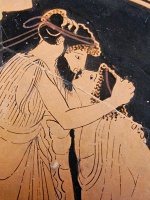Hoop rolling (ancient Greece)
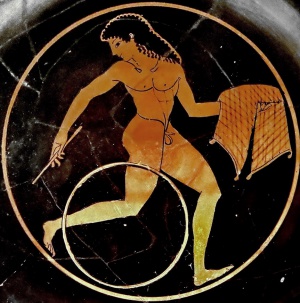
Youth with hoop and covered cake as a love gift
Hoop rolling, also called hoop trundling, is both a sport and a child's game in which a large hoop is rolled along the ground, generally by means of an object wielded by the player. The aim of the game is to keep the hoop upright for long periods of time, or to do various tricks.
The hoop held symbolic meanings in ancient Greek myth and culture, and was used to represent a boy or youth in general in Greek art. The Greeks referred to the hoop as trochus or krikoi, and they were probably made of bronze, iron or copper. They were rolled with a stick called elater.[1]
A bronze hoop was one of the toys of the infant Dionysus,[2] and the hoop is an attribute of Ganymede, often depicted on Greek vase paintings from the 5th century BC. It was a popular toy in ancient Greece, the sport being regarded as healthful, and was recommended by Hippocrates for strengthening weak constitutions.[3]
Images of the hoop are often presented in the context of pederasty in ancient Greece.[4] A hoop was a favorite gift given by a Greek man to the boy he fancied [5], as well as gifts of animals or meat. In vase paintings, a spear, trident or wooden staff is sometimes depicted penetrating the boy's hoop, as a symbolic allusion to the sexual nature of the relationship.[6]
| Part of the boylove history series |
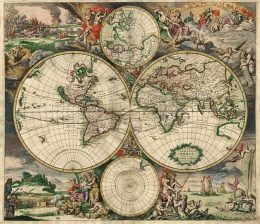 |
| Portal:History |
Zeus and Ganymede
The images below are from a red-figure bell Krater depicting Ganymede and Zeus attributed to the Berlin Painter circa 500-480 BC. Kraters were used at banquets for mixing wine and water.[7] Zeus is shown pursuing the boy Ganymede, who is playings with a toy hoop, symbol of his youth, and a cock, a traditional gift given to boys by their male suitors. [8] The two images taken together convey the pederastic or sexual nature of the relationship.
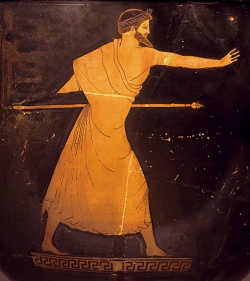 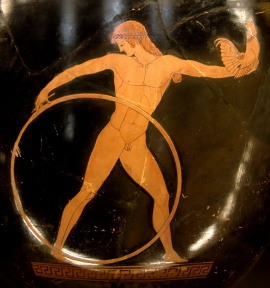 |
References
- ↑ Athletics and Games of the Ancient Greeks By Edward M Plummer; p50
- ↑ Forerunners and Rivals of Christianity: Being Studies in Religious History from 330 B.C. to 330 A.D. by Francis Legge; 1915 p. 125
- ↑ "Hippocrates recommended playing with a hoop as a cure for weak people" Psychoanalytic perspectives on art: PPA, Volume 1 - Page 97 by Mary Mathews Gedo
- ↑ The ancient Olympics By Nigel Jonathan Spivey; p48
- ↑ http://www.scribd.com/doc/153553844/Sexuality-in-Greek-and-Roman-Culture
- ↑ http://www.homoerotimuseum.net/eur/eur07/329.html
- ↑ http://www.mam.gov.mo/photodetail.asp?productkey=2008041201094&lc=3
- ↑ http://www.louvre.fr/en/oeuvre-notices/attic-red-figure-bell-krater
